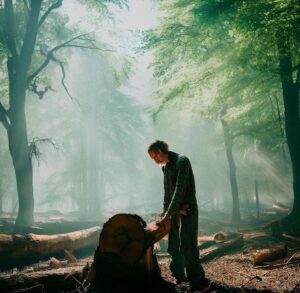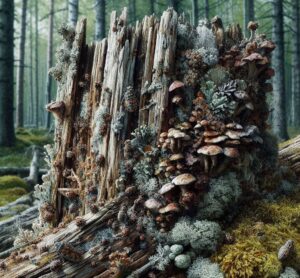In the pristine expanse of native woodlands, life thrives, not just in the green vibrancy of leafy canopies, but paradoxically, in the seemingly lifeless form called dead wood. As its name implies, dead wood consists of trees that are no longer alive due to natural causes or human interference. Its vital role in the ecosystem often gets overlooked in ecological evaluations. The ecological value of dead wood is immense: it plays host to various forms of life, contributes to nutrient cycling, and aids in carbon storage – all essential aspects of a healthy, thriving ecosystem.
What is Dead Wood?
Dead wood plays a key role in the balance of the forest ecosystem. As trees age and eventually die, they begin to decompose and gradually break down, returning essential nutrients to the soil. This decomposition process supports the growth of fungi, plants, and other organisms, which is essential for maintaining biodiversity. Dead wood serves as a habitat and food source for a variety of woodland creatures, including insects, birds, and mammals. For some species, dead wood is the preferred or even the only suitable habitat. The presence of dead wood can also influence the moisture levels and temperature regulation within the forest, impacting the overall climate of the environment. The preservation and management of dead wood in forest ecosystems is crucial to sustaining a healthy and diverse forest life.
The Ecological Significance of Dead Wood

Dead wood exists as a significant habitat providing refuge and breeding grounds for a myriad of species including insects, fungi, lichens, mosses, and mammals. There are a surprising number of species whose survival relies exclusively on the presence of dead wood in the ecosystem. For example, several insects require the rotting wood to complete their life cycles, laying their eggs within the wood for the larvae to feed upon it. Many small mammals and birds also utilize cavities in dead wood for nesting and protection.
The role of dead wood in nutrient cycling is critical. When a tree dies, the process of decomposition starts, carried out by an army of detritivores such as fungi and insects. As they break down the dead wood, they convert and release the nutrients that were once a part of living tissues back into the soil. This natural recycling process helps maintain soil fertility, which in turn supports the growth of healthy plant life. Without this cycle, nutrients would be locked away in non-decomposing material, leading to a decline in the health and productivity of the ecosystem.
Still standing trees and dead wood act as significant carbon sinks by storing carbon that would otherwise be released into the atmosphere, thus mitigating climate change. When a tree grows, it absorbs carbon dioxide from the atmosphere, and a portion of this carbon remains stored within the tree even after it dies. Therefore, the more dead wood that is present in an ecosystem, the more carbon is held within that system and the less is released back into the atmosphere. As increasing levels of carbon dioxide in the atmosphere are a primary driver of global warming, dead wood’s role as a carbon sink further underscores its ecological importance.
The ecological significance of dead wood extends far beyond just being remnants of fallen trees. It fosters biodiversity as a habitat, ensures the health of the ecosystem by contributing to nutrient cycling, and even aids in combating climate change by storing carbon. With such wide-reaching impacts, the conservation and management of dead wood are essential for preserving the health and balance of forest ecosystems.
Dead Wood as Habitats
The importance of dead wood as a habitat cannot be overstated. Its structural complexity and the varying stages of decomposition offer a myriad of microhabitats for different species to inhabit. Each dead tree or log provides a unique ecological niche, often supporting communities of organisms that live within, under, and on it.
Woodpeckers, for instance, are known as primary cavity nesters because they excavate their nest cavities in the trunks or branches of dead or dying trees, often called “snags”. These cavities can provide nesting sites or shelter for secondary cavity users such as owls, squirrels, bats, and other bird species that cannot make their own cavities. Dead trees also provide ample foraging opportunities for woodpeckers and other bark-foraging birds seeking insects and grubs living under the bark.
Many insects, such as beetles, ants and termites, thrive in dead wood by burrowing tunnels and making it their home. These decomposers not only feed on the dead wood, but also contribute to the process of decomposition, breaking down the dead organic material into nutrients that enrich the soil.
Fungi, lichens, and mosses also find the humid and nutrient-rich environment inside and on top of dead wood to be the perfect growing conditions. Fungi and certain bacteria can decompose the tough lignin and cellulose found in wood tissue, a task few other organisms can perform. Some types of fungi even form mutualistic relationships with tree roots, enhancing nutrient uptake for the tree in exchange for carbohydrates, in an underground network known as the wood-wide web.
Many animals use dead wood as hiding places or hunting grounds. For instance, small mammals might use fallen logs as transportation corridors or as a refuge from predators, while reptiles, such as snakes, use them as basking sites.
All these interactions with dead wood contribute to making woodland ecosystems rich in species diversity. Such diversity is key to the ecosystem’s stability and resilience, showing the importance of dead wood in maintaining the health of our forests.
Dead Wood: A Carbon Storehouse

Trees, alive or dead, play a crucial role in the global carbon cycle due to their ability to absorb, store, and eventually release carbon dioxide (CO2). While alive, trees use photosynthesis to convert CO2 from the atmosphere into glucose for growth, storing the excess carbon in their biomass. When a tree dies, it transitions from being a carbon absorber to a carbon storehouse. The carbon sequestered during the tree’s life remains locked within its biomass, even as it turns into dead wood.
This stored carbon is gradually released back to the atmosphere during decomposition, a process that involves fungi, bacteria, and invertebrates breaking down the dead wood over a considerable period of time. Depending on several factors including the tree species, size of the log, climatic conditions, and other environmental variables, this could take years, decades, or even centuries. Throughout this prolonged process, a significant amount of carbon remains sequestered in the dead wood, preventing its immediate release back into the atmosphere.
The carbon storage capacity of dead wood underscores its importance in efforts to mitigate climate change. By serving as a carbon reservoir, dead wood helps limit the amount of carbon dioxide—a primary greenhouse gas—released into the atmosphere. Greenhouse gases, as we know, trap heat within the earth’s atmosphere, contributing to global warming and subsequent climate change. Hence, the presence of dead wood in our forests plays an impactful role in limiting the pace and severity of climate change.
Dead wood also indirectly enhances the carbon storage capacity of the forest system. Its role in nutrient cycling contributes to soil fertility, which in turn affects forest productivity and the capacity of the forest to sequester carbon in live biomass. It’s evident from this perspective that the intricate balance between life, death, and rebirth in a forest establishes it as a crucial carbon sink, with dead wood being an integral component of the system.
To maximize the potential of forests and dead wood as carbon sinks, it’s important that we manage them wisely, ensuring conservation and appropriate use of forest resource. Equally important is a reduction in deforestation and forest degradation, as well as the reforestation and restoration of degraded lands.
Human activities pose a grave threat to dead wood resources. Intensive logging, clearance for agricultural activities, and firewood collection cause significant reductions in dead wood within woodlands. As a result, the associated biodiversity can be severely impacted, and the carbon stored within dead wood may prematurely re-enter the carbon cycle, posing further climate change risks.